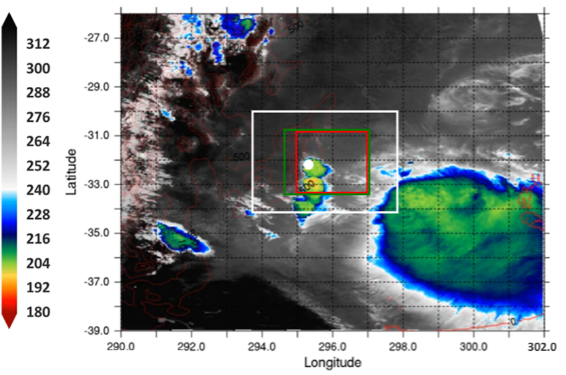Case Description: 25 January 2019
Summary
Extremely deep cells merge into a large squall
Description
Relatively calm background in the immediate region until four convective initiations begin along the ridgeline at 17:30 UTC over and to the south of the site. They all grow rapidly into intense, organized systems and merge into a single multi-cell system by 18 UTC. The system grows quickly to become massive by the end of the day, covering at least a third of the outermost WRF mesoscale domain (see Figure 2). Potentially a challenging simulation because of the multi-cell interactions, some of which are also too far south for the CSAPR2 to observe and will interact with the LES lateral boundary. CAPE values are anomalously high outliers (at 15 UTC MUCAPE=5863; MLCAPE=3279 J kg-1).
Available assets
CSAPR2, CSU C-Band data, GOES rapid scan
Unavailable: G1, RELAMPAGO data
Critical period: 17:00–22:00

Figure 9 GOES16 band 13 brightness temperature at 2019-01-25 at 18:00 UTC. Four intense, organized systems start to merge into a single mesoscale convective system that continues to grow to cover one third of the WRF mesoscale domain.
Available LES ensemble members
Impression |
Ensemble Member |
Cloud Behavior |
|---|---|---|
Marginal |
EDA07 |
Location and tming are great, but it underdevelops, especially over the AMF1. CSK Skill much less than respective meso run. |
Acceptable |
EDA07-Morr |
Convective initiation and timing are good with strong upscale growth. The cells combine into the large area observed, giving excellent agreement for the developed system with CSK Skill >0.8. |
Eh |
GEFS11 |
CSK Skill much lower than respective meso run. Location and timing are good but simulation develops a streak pattern versus the blobs observed. |